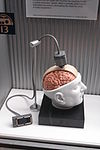
BrainGate
Encyclopedia

Brain implant
Brain implants, often referred to as neural implants, are technological devices that connect directly to a biological subject's brain - usually placed on the surface of the brain, or attached to the brain's cortex...
system developed by the bio-tech company Cyberkinetics
Cyberkinetics
Cyberkinetics is an American company. It was cofounded by John Donoghue, Mijail Serruya, and Gerhard Friehs of Brown University and Nicho Hatsopoulos of the University of Chicago. The Braingate technology and related Cyberkinetic’s assets are now owned by privately held Braingate, LLC...
in 2008 in conjunction with the Department of Neuroscience at Brown University
Brown University
Brown University is a private, Ivy League university located in Providence, Rhode Island, United States. Founded in 1764 prior to American independence from the British Empire as the College in the English Colony of Rhode Island and Providence Plantations early in the reign of King George III ,...
. The Braingate technology and related Cyberkinetic’s assets are now owned by privately held Braingate, LLC. The device was designed to help those who have lost control of their limbs
Limb (anatomy)
A limb is a jointed, or prehensile , appendage of the human or other animal body....
, or other bodily functions, such as patients with amyotrophic lateral sclerosis
Amyotrophic lateral sclerosis
Amyotrophic lateral sclerosis , also referred to as Lou Gehrig's disease, is a form of motor neuron disease caused by the degeneration of upper and lower neurons, located in the ventral horn of the spinal cord and the cortical neurons that provide their efferent input...
(ALS) or spinal cord injury
Spinal cord injury
A spinal cord injury refers to any injury to the spinal cord that is caused by trauma instead of disease. Depending on where the spinal cord and nerve roots are damaged, the symptoms can vary widely, from pain to paralysis to incontinence...
. The computer chip, which is implanted into the brain
Brain
The brain is the center of the nervous system in all vertebrate and most invertebrate animals—only a few primitive invertebrates such as sponges, jellyfish, sea squirts and starfishes do not have one. It is located in the head, usually close to primary sensory apparatus such as vision, hearing,...
, monitors brain activity in the patient and converts the intention of the user into computer commands.
Currently the chip uses 96 hair-thin electrodes that sense the electro-magnetic signature of neurons firing in specific areas of the brain, for example, the area that controls arm movement. The activity is translated into electrically charged signals and are then sent and decoded using a program, which can move a robotic arm, a computer cursor, or even a wheelchair. According to the Cyberkinetics' website, three patients have been implanted with the BrainGate system. The company has confirmed that their first patient, Matt Nagle
Matt Nagle
Matthew Nagle was one of the first persons to use a brain-computer interface to restore functionality lost due to paralysis. He was a C3 tetraplegic, paralyzed from the neck down after being stabbed.-Biography:...
, had a spinal cord injury, whilst another has advanced ALS
Amyotrophic lateral sclerosis
Amyotrophic lateral sclerosis , also referred to as Lou Gehrig's disease, is a form of motor neuron disease caused by the degeneration of upper and lower neurons, located in the ventral horn of the spinal cord and the cortical neurons that provide their efferent input...
.
In addition to real-time analysis of neuron patterns to relay movement, the Braingate array is also capable of recording electrical data for later analysis. A potential use of this feature would be for a neurologist
Neurologist
A neurologist is a physician who specializes in neurology, and is trained to investigate, or diagnose and treat neurological disorders.Neurology is the medical specialty related to the human nervous system. The nervous system encompasses the brain, spinal cord, and peripheral nerves. A specialist...
to study seizure patterns in a patient with epilepsy
Epilepsy
Epilepsy is a common chronic neurological disorder characterized by seizures. These seizures are transient signs and/or symptoms of abnormal, excessive or hypersynchronous neuronal activity in the brain.About 50 million people worldwide have epilepsy, and nearly two out of every three new cases...
.
In 2009, a monkey code named JI1021 used a device very similar to BrainGate to control a robotic arm.
Clinical Trials
As of July 8, 2009, clinical Trials are being conducted for the Brain Gate 2 Neural Interface System.See also
- Brain-computer interfaceBrain-computer interfaceA brain–computer interface , sometimes called a direct neural interface or a brain–machine interface , is a direct communication pathway between the brain and an external device...
- Describes human trials with BrainGate - Simulated realitySimulated realitySimulated reality is the proposition that reality could be simulated—perhaps by computer simulation—to a degree indistinguishable from "true" reality. It could contain conscious minds which may or may not be fully aware that they are living inside a simulation....

